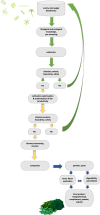Challenging microalgal vitamins for human health
- PMID: 33138823
- PMCID: PMC7607653
- DOI: 10.1186/s12934-020-01459-1
Challenging microalgal vitamins for human health
Abstract
Background: Vitamins' deficiency in humans is an important threat worldwide and requires solutions. In the concept of natural biofactory for bioactive compounds production, microalgae represent one of the most promising targets filling many biotechnological applications, and allowing the development of an eco-sustainable production of natural bioactive metabolites. Vitamins are probably one of the cutting edges of microalgal diversity compounds.
Main text: Microalgae can usefully provide many of the required vitamins in humans, more than terrestrial plants, for instance. Indeed, vitamins D and K, little present in many plants or fruits, are instead available from microalgae. The same occurs for some vitamins B (B12, B9, B6), while the other vitamins (A, C, D, E) are also provided by microalgae. This large panel of vitamins diversity in microalgal cells represents an exploitable platform in order to use them as natural vitamins' producers for human consumption. This study aims to provide an integrative overview on vitamins content in the microalgal realm, and discuss on the great potential of microalgae as sources of different forms of vitamins to be included as functional ingredients in food or nutraceuticals for the human health. We report on the biological roles of vitamins in microalgae, the current knowledge on their modulation by environmental or biological forcing and on the biological activity of the different vitamins in human metabolism and health protection.
Conclusion: Finally, we critically discuss the challenges for promoting microalgae as a relevant source of vitamins, further enhancing the interests of microalgal "biofactory" for biotechnological applications, such as in nutraceuticals or cosmeceuticals.
Keywords: Antioxidants; Biotechnology; Microalgae; Nutraceuticals; Vitamin D; Vitamin K.
Conflict of interest statement
The authors declare that they have no competing interests.
Figures




References
-
- Vicente AR, Manganaris GA, Sozzi GO, Crisosto CH. Nutritional quality of fruits and vegetables. Postharvest Handling. 2009 doi: 10.1016/B978-0-12-374112-7.00005-6. - DOI
-
- Jung F, Krüger-Genge A, Waldeck P, Küpper J-H. Spirulina platensis, a super food? J Cell Biotechnol. 2019;5(1):43–54. doi: 10.3233/JCB-189012. - DOI
Publication types
MeSH terms
Substances
Grants and funding
LinkOut - more resources
Full Text Sources

